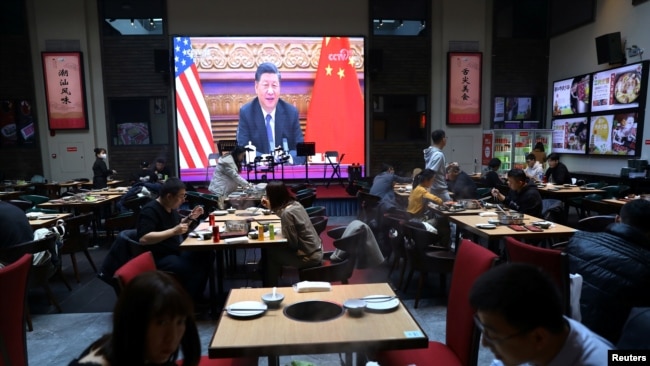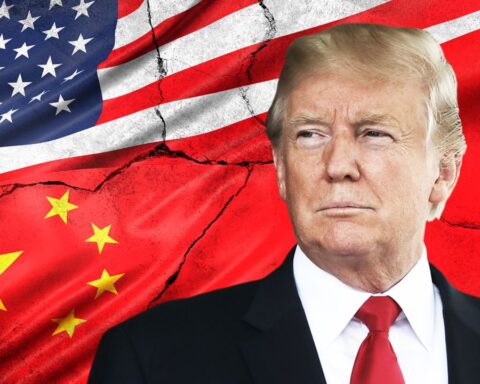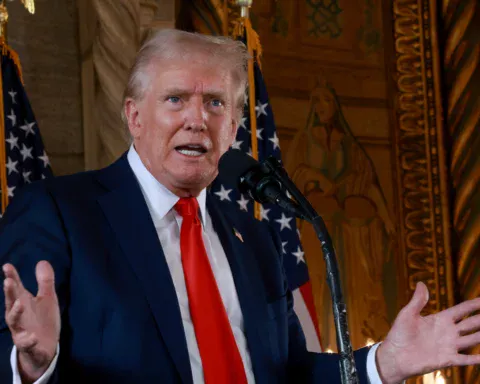WHITE HOUSE — The White House said early Tuesday that U.S. President Joe Biden “welcomed the opportunity to speak candidly and straightforwardly” to his Chinese counterpart, Xi Jinping, about issues including human rights, economic competition and Taiwan in their first one-on-one meeting since Biden took office.
“President Biden underscored that the United States will continue to stand up for its interests and values and, together with our allies and partners, ensure the rules of the road for the 21st century advance an international system that is free, open, and fair,” the White House said in a statement issued just after midnight Tuesday, following the end of their more than three-hour virtual meeting. “He emphasized the priority he places on far-reaching investments at home while we align with allies and partners abroad to take on the challenges of our time.”
But Biden seemed to temper previous statements he had made in Taiwan’s defense.
The White House statement said the United States supports the One China policy, opposes Taiwan’s independence and “strongly opposes unilateral efforts to change the status quo or undermine peace and stability across the Taiwan Strait.” Those assurances are likely to placate Beijing, with China’s foreign minister saying in the runup to talks that the United States needed to “stop sending wrong signals to the ‘Taiwan independence’ forces.”
In all, a senior administration official said early Tuesday, the two leaders spoke for longer than anticipated, in two sessions spread over three and a half hours.
“You know, we were not expecting a breakthrough,” the administration official told reporters. “There were none, none to report.”
When asked if the talks managed to reduce tensions between the two superpowers, the administration official said that wasn’t the goal of talks and that the relationship between the two shouldn’t be viewed as one that has ups and downs.
“I don’t think the purpose was to particularly ease tensions or necessarily the result,” the official said.

‘Just Simple, Straightforward Competition’
Biden launched the marathon meeting with a friendly greeting before shifting quickly into a sober reflection on the challenges that divide the two nations.
“It seems to me that our responsibility as leaders of China and the United States is to ensure that the competition between our countries does not veer into conflict,” Biden said Monday as the two leaders spoke in a video call between Washington and Beijing. “Whether intended or unintended — just simple, straightforward competition.”
Xi also acknowledged the many issues between the two great powers and, as expected, defended his nation’s sovereignty against what Beijing has long perceived as American and international judgment and pressure.
“We should each run our domestic affairs well and, at the same time, shoulder our share of international responsibilities and work together to advance the noble cause of world peace and development,” Xi said. “This is a shared desire of the people of our two countries and around the world.”
Biden emphasized that the countries need to establish “guardrails” to avoid conflict and work together where possible on issues such as climate change. That was among the other issues the leaders discussed, the White House said, which also included discussions on regional challenges including North Korea, Afghanistan, and Iran.
On upcoming denuclearization talks with Iran, the senior administration official told VOA that the two sides exchanged views on their expectations ahead of negotiations, and will seek ways to ensure that the talks, which are set to resume at the end of the month, are productive.

The United States sees China as its strategic competitor, with Beijing making gains on its military and economic dominance around the world. The two are embroiled in diplomatic, legal, technological and economic disputes that are volatile and prone to escalation. There have been clashes over intellectual property and tariffs as well as regional flashpoints that could spiral into armed conflict, including in the Taiwan Strait and in the South China and East China seas.
A senior administration official told reporters on background Sunday that this meeting is “not about agreeing to a specific deliverable or outcome.”
A lack of tangible outcomes is not necessarily a bad thing, said Matthew Goodman, Senior Vice President for economics at the Center for Strategic and International Studies, noting that U.S.-China relations were at a historic low.
“It’s an important moment, I think, even if not much comes out of it,” he said. “It’s important for the two leaders to talk.”
The White House said that Biden raised concerns about human rights in Xinjiang, Tibet, Hong Kong, and more broadly. He also pushed Xi over what the U.S. sees as unfair trade and economic practices by China.
Many observers are pessimistic that the meeting will change the two countries’ relationship in a meaningful way.
“This not the Sunnylands summit,” said Patrick Cronin, the Asia-Pacific security chair at the Hudson Institute, referring to the 2013 meeting between then-President Barack Obama and Xi, at a retreat center in California, that placed the U.S.-China bilateral relationship on more solid footing and paved the way for nuclear diplomacy with North Korea. “The relationship has changed — it’s more precarious, it’s more tense,” Cronin said.
While both sides would like to avoid conflict, neither appears willing to back down on what it considers core values and interests — and many of them are simply incompatible.
“There is no evidence that either leader has fundamentally reconsidered his interest, his goals, his strategy,” said Robert Daly, director of the Wilson Center’s Kissinger Institute on China and the United States. “So, the leaders are searching for some sort of formula that meets each other’s minimal goals that will allow them to try to manage this competition, rather than have it escalate to conflict.”
Historian Jeremi Suri of the University of Texas at Austin observed that the peculiar logistics of a virtual meeting could have an impact.
“This might be the wave of the future, where one side doesn’t have to concede that ‘I will go to your home court,’” Suri said. “But instead, they’re both on their own home court. So, I think this was actually a very good first step, where both leaders can feel that they’re in control.”
Washington and Beijing have secured a small positive step ahead of the meeting. At the COP26 climate summit in Glasgow, Scotland, earlier this month, the world’s two biggest CO2 emitters unexpectedly announced they would work together to slash emissions and meet regularly to address the climate crisis.
And, in what was likely an intentional sartorial signal between two leaders for whom every optical detail matters, Biden appeared Monday night wearing a tie of vivid red — considered an auspicious color in Chinese culture. Xi sported a tie in the signature blue of Biden’s Democratic Party.
Paris Huang and Nike Ching contributed to the report.






